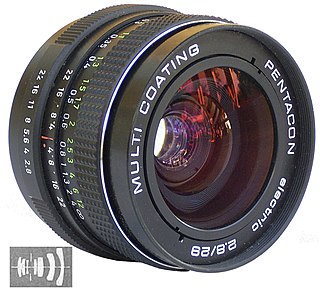
The Four Thirds System is a standard created by Olympus and Eastman Kodak for digital single-lens reflex camera (DSLR) and mirrorless camera design and development.

The Lumix DMC-L10 is Panasonic's second digital single-lens reflex camera (DSLR), a follow-up to the previous Lumix DMC-L1 model. It was announced in August 2007, and, like the Lumix DMC-L1, this model uses the Four Thirds System lens mount standard and contains some basic parts provided by Olympus.
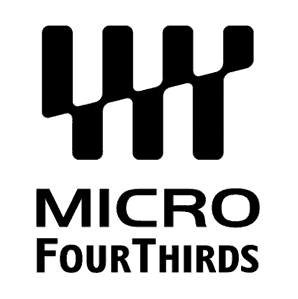
The Micro Four Thirds system is a standard released by Olympus and Panasonic in 2008, for the design and development of mirrorless interchangeable lens digital cameras, camcorders and lenses. Camera bodies are available from Blackmagic, DJI, JVC, Kodak, Olympus, Panasonic, Sharp Corporation, and Xiaomi. MFT lenses are produced by Cosina Voigtländer, DJI, Kowa, Kodak, Mitakon, Olympus, Panasonic, Samyang, Sharp Corporation, Sigma, SLR Magic, Tamron, Tokina, Veydra, and Xiaomi, amongst others.

The Panasonic Lumix DMC-G1 was the first digital mirrorless interchangeable-lens camera (MILC) adhering to the Micro Four Thirds system design standard. The G1 camera is similar to the larger Four Thirds system format DSLR cameras, but replaces the complex optical path needed for the optical viewfinder with an electronic viewfinder EVF displaying a live view image directly from the sensor. Eliminating the mirror box and optical viewfinder allows for smaller and lighter camera bodies, while the less complex optical path also allows for smaller, lighter lens designs.

The Panasonic Lumix DMC-GH1 is a digital mirrorless interchangeable lens camera adhering to the Olympus and Panasonic developed Micro Four Thirds System (MFT) system design standard. Panasonic classified the GH1 as a hybrid stills/video camera and the GH1 was introduced and marketed as a higher end camera than Panasonic's first MFT camera, the stills only, non-video capable Lumix DMC-G1.

The Olympus Pen E-P1 announced on 16 June 2009 is Olympus Corporation's first camera that adheres to the Micro Four Thirds (MFT) system design standard. The first camera to use the Micro Four Thirds mount was Panasonic's G-1 camera.

The Olympus Pen E-P2 announced on 5 November 2009 is Olympus Corporation's second camera that adheres to the Micro Four Thirds (MFT) system design standard. The E-P2 succeeds the Olympus Pen E-P1 a little over five months after the introduction of the EP-1.

The Olympus PEN E-PL1, announced on 3 February 2010 was Olympus Corporation's third camera using the Micro Four Thirds system mount after the Olympus PEN E-P1 and Olympus PEN E-P2. It was the first camera in Olympus' "PEN Lite" line.

A mirrorless interchangeable lens camera (MILC), frequently simply mirrorless camera, and sometimes also called EVIL features a single, removable lens and uses a digital display system rather than an optical viewfinder. The word "mirrorless" indicates that the camera does not have an optical mirror or an optical viewfinder like a conventional single-lens reflex camera (SLR), but an electronic viewfinder which displays what the camera image sensor sees.
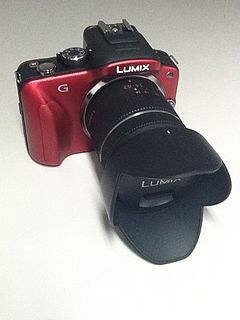
The Panasonic Lumix DMC-G3 is a digital mirrorless interchangeable lens camera adhering to the joint Olympus and Panasonic Micro Four Thirds System (MFT) system design standard. The Panasonic Lumix DMC-G3 is the eighth Panasonic MFT camera introduced under the standard and the thirteenth model MFT camera introduced by either Olympus or Panasonic, as of the G3 product announcement date.
The Olympus M.Zuiko Digital ED 12mm f/2 is a Micro Four Thirds System Prime lens by Olympus Corporation. In the Micro Four Thirds format, it is a wide- or ultra-wide lens.

The Panasonic Lumix DMC-G2 is a digital mirrorless interchangeable lens camera adhering to the Olympus and Panasonic developed Micro Four Thirds System (MFT) system design standard.
The Panasonic Lumix DMC-G10 is the sixth digital mirrorless interchangeable lens camera introduced that adheres to the Micro Four Thirds System (MFT) system design standard, and the fourth Panasonic model MFT camera. The G10 model was announced concurrently with its more capable sibling, the Panasonic Lumix DMC-G2, in March 2010.
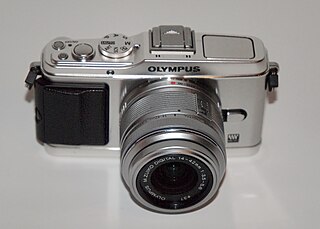
The Olympus PEN E-P3 announced on 30 June 2011 is Olympus Corporation's seventh camera that adheres to the Micro Four Thirds (MFT) system design standard. The E-P3 succeeds the Olympus PEN E-P2, and was announced in concert with two other models, the Olympus PEN E-PL3, and the Olympus PEN E-PM1.

Panasonic Lumix DMC-GF3 is the eighth camera in Panasonic's Lumix G-series adhering to the Micro Four Thirds System (MFT) design standard, and was announced in June, 2011.
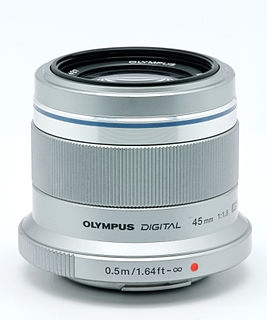
The M.Zuiko Digital 45 mm f/1.8 is a prime lens by Olympus Corporation, for the Micro Four Thirds System. It is sold in a kit with the Olympus PEN camera body and available separately.

The Olympus PEN E-PM1 is an entry-level mirrorless interchangeable-lens camera from Japanese manufacturer Olympus with a Micro Four Thirds lens mount and sensor. It includes a 12.3 megapixel sensor, 3-inch 460,000 pixel LCD screen, and sensor-based image stabilization, but no viewfinder or internal flash, although an external flash can be fitted.
The Kodak Pixpro S-1 is a rangefinder-styled digital mirrorless camera announced on January 7, 2014, and first shipped in August 2014. It is the first interchangeable lens camera made under the Kodak brand since JK Imaging bought the rights to "manufacture and sell Kodak branded digital imaging products", as described in promotional materials. Kodak is one of the original members of the Micro Four Thirds standard but had never before produced a camera for it. The camera is produced in partnership with Asia Optical.
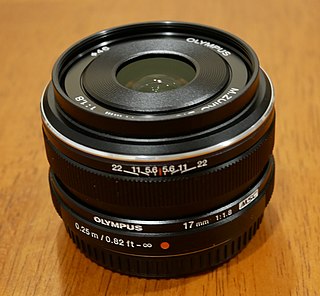
The M.Zuiko Digital 17 mm f/1.8 is a prime lens by Olympus Corporation, for the Micro Four Thirds System. Originally introduced in 2012, the lens features a silent movies and still compatible focusing motor. The lens, like other Olympus lenses, can switch from auto focus to manual focus by pulling back in its focusing ring.

The Zuiko Digital 14–54 mm f/2.8–3.5 is a Four Thirds System High Grade series lens by Olympus Corporation, initially sold in a kit with the Olympus E-1 camera body and also available separately. Three glass aspherical lenses are used in its optical formulation. It was positioned as an upgrade to the 14-45mm kit lens in terms of focal length range while having larger apertures. It was replaced as the premium kit lens by the Olympus Zuiko Digital ED 12-60mm f/2.8-4 SWD with the release of the E-3, and later was directly replaced by the Olympus Zuiko Digital 14-54mm f/2.8-3.5 II, which is more suited for mirror-up or mirrorless operation.

